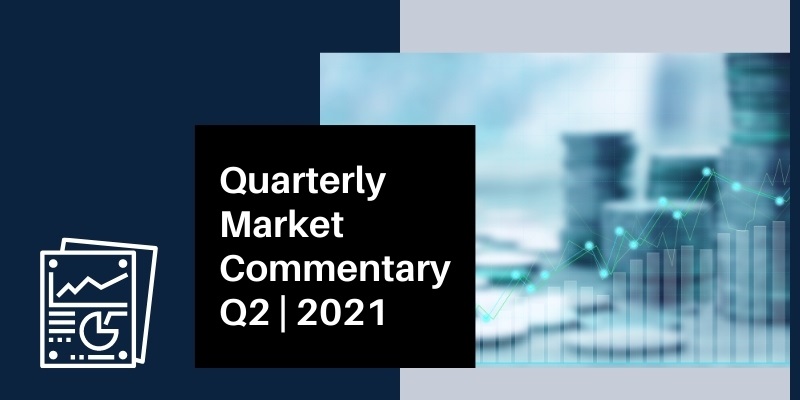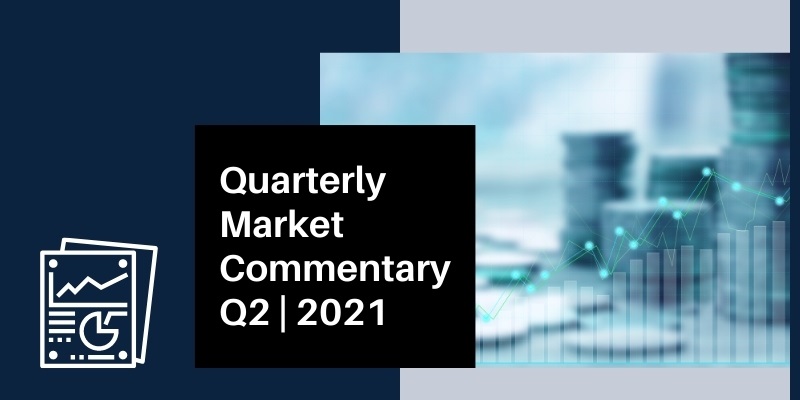
Stocks Continue to Rally in Q1
Despite a recent pick-up in volatility tied to inflation concerns, stocks experienced a strong start to the year, with the S&P 500 up +5.8% during the first quarter. With that said, there was some disparity in performance across sectors, with Value stocks outperforming Growth stocks by over 9% during Q1 and small cap stocks outperforming large caps by nearly 7%. While optimism regarding the economic growth outlook combined with positive vaccine progress helped to underpin stock market strength, a pro-cyclical rotation drove the disparity across various industries and sectors. Specifically, those companies set to benefit the most from re-opening broadly outperformed, while stocks that outperformed in 2020 – principally tech oriented businesses that benefited from the advantages afforded by the socially distanced economy – largely underperformed during Q1. Amongst those sectors that did particularly well were airlines, machinery, hospitality, energy, and building materials, while financials benefited from a backdrop of rising interest rates.
The disparity in performance underscores the importance of maintaining broadly diversified allocations across sectors and discipline with respect to rebalancing. For instance, through the latter half of last year we were focused on reducing overweight exposures to Growth stocks in favor of Value stocks, and we also had been reducing large cap positioning in favor of small caps based on relative performance, while adding to real estate positions. Real Estate was one of the better performing asset classes in Q1.
Improved Economic Outlook
With a backdrop of massive central bank and Government stimulus, the economy continues to do better than anticipated and economic projections continue to be revised higher. The Fed has indicated it does not anticipate raising short-term interest rates until at least 2023 and will maintain an accommodative monetary stance to support the nascent economic recovery for the foreseeable future. At the same time, massive fiscal stimulus in the form of the recently passed $1.9 trillion coronavirus relief package and potential for further infrastructure spending has underpinned heightened growth expectations. Some concerns have been raised regarding mounting Federal debt, however the Government’s ability to service that debt remains stronger than long-term averages by way of historically low interest rates. Even factoring in a backdrop of rising interest rates, we do not consider debt servicing costs pose a near-term risk. Regardless, fiscal adjustments will eventually be required in the coming years.
Corporate earnings also reflect an uptick in economic sentiment, with Q4 2020 earnings growth unexpectedly turning positive, while Q1 2021 estimates were revised higher and corporate commentary broadly signaled a more positive outlook. Indeed, Wall Street is estimating S&P 500 earnings growth of close to 25% for 2021.
We have also witnessed improving coronavirus case and hospitalization trends. After peaking in mid-January, we experienced meaningful improvement throughout much of the quarter. Sentiment was also buoyed by an acceleration in vaccine distribution. The U.S. averaged nearly 2.5 million COVID vaccine doses per day by the end of the quarter and has already administered more than 150 million doses nationwide. Positive vaccine sentiment in turn helped drive a pickup in economic indicators, particularly with regards to consumer spending. This is important, given consumer spending contributes approximately 70% of GDP.
Yields Move Higher
As a function of the improved economic outlook and massive expansionary policies, inflation concerns came to the fore in the first quarter, driving bond yields higher. The benchmark 10 year yield ended Q1 at 1.74%, up from 0.92% at the beginning of the year. As a result, the broad bond market struggled through the first quarter, with the Bloomberg Barclays Aggregate Bond index falling -3.3%. Leading into 2021, we had anticipated a rising interest rate environment and had positioned our core fixed income allocations accordingly, with less duration risk (interest rate sensitivity) than the broad bond market and actively avoiding areas of the bond market most susceptible to interest rate changes, such as long-duration Treasuries in the 10 year – 30 year maturity range. We have also maintained dedicated allocations to actively managed bond funds and fixed income asset classes we consider may perform relatively well in a rising interest rate environment. Consequentially, our bond portfolios held up comparatively well over the first quarter of 2021.
Outlook
We consider the massive monetary and fiscal policies may continue to act as a positive tailwind underpinning stock market returns moving forward. The last time the Fed was this accommodative was in the aftermath of the Great Financial Crisis of 2008. In the years that followed the relationship between the Fed’s expansionary monetary policies and the S&P 500 was strongly positive. We anticipate bond yields may grind higher over the medium term, but believe we are well positioned to navigate such an environment. Ultimately, we believe our broadly diversified portfolios are well constructed to continue to meet the long-term financial goals of our clients.
00398218 04/21


